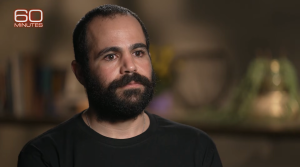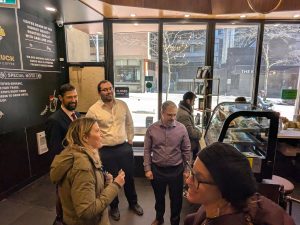Ralph Benmergui is the host of The CJN’s podcast about Jewish life in smaller Canadian places, Yehupetzville, the spiritual podcast Not That Kind of Rabbi, and now the author of I Thought He Was Dead.
Over the years, I had often researched pathways to becoming a rabbi. I wasn’t ever able to convince myself that with my poor command—as in almost none—of the Hebrew language I would be accepted by any institutions. I realized that I had been looking at these websites for more than 20 years. And every time I reasoned that I couldn’t take the five years off it required, or that I wouldn’t be able to bear the weight of rabbinical obligations. But here I was again, taking one more look.
There is an ebb and flow to my spirituality. When the tide is in, I am awash with feelings of unity and find that the doorway to my compassion opens just enough to let in the beauty and sorrow of this existence. The triggers vary for this open heartedness. Sometime it’s the approach of our highest holidays and the call to reflection, repentance and service. Other times it’s my own sadness or despair for the plight of so many for so few reasons. I, for instance, find myself occasionally crying for the earth that sustains us. The hardened heart of our every man, and I do mean man, for himself culture. Ironically, we prop up the billionaires not because they understand us but because we hope that through them we can ourselves become rich, powerful, immune. Upton Sinclair, the American writer, said it well: “It is difficult to get a man to understand something when his salary depends on him not understanding it.” John Steinbeck, another American dissident writer, said so eloquently, “Socialism never took root in America because the poor see themselves not as exploited proletariat but as temporarily embarrassed millionaires.”
My soul wanderings are not the kind that will make me a religious scholar. I don’t know how many angels dance on the head of a pin. So, what was I doing staring at a screen and wondering if I should take one last poke at the rabbinical piñata? I returned to the form of Judaism that has always been aligned with my disposition, Jewish Renewal. A movement that was born of the hippie days of West Coast America. Its founders were well grounded in orthodoxy and yet had found a way to infuse the cosmic gut punch of psychedelia and the mystic traditions of the Hasidic movement into a new-age Judaism that spoke to those that yearned for more mystery and less certitude.
From that form of Judaism emerged rabbis like Shlomo Carlebach, “the Singing Rabbi”; Arthur Waskow, the leading proponent of an Earth-based Judaism that reconnected Jewish teachings with stewardship of the planet; and most impactful of them all, Reb Zalman Schachter-Shalomi. With books Like Paradigm Shift and From Age-ing to Sage-ing, Reb Zalman brought a magical synthesis of classical and profound Jewish practice and tradition into the twentieth century and now beyond. He asked questions like, “How do you get it on with God?” He launched a dialogue with the Dalai Lama that was captured in Rodger Kamenetz’s wonderful book, The Jew in the Lotus.
I was hooked. As a teenager, I was a tail-end baby boomer. That meant I could only see the Earth-based and communal experiment of the hippie generation from a distance. I was too young to participate actively but old enough to attach myself to the utopian ideals that were launched in the face of a dour and war-addicted western world rife with cruel “isms.”
God as mystery, people as beings—all beings—infused with a spark of the divine that could be activated by the connection of one heart to another. The teachings, seen through the lens of unity, took on a rich meaning for me that never truly left. So here I was, scrolling down the course curriculum for a place called the ALEPH Ordination Program. There were choices: rabbi, rabbinic pastor—never heard of that before—and finally, Hashpa’ah, or Jewish spiritual direction. I gravitated toward that, the one I could do while still providing for my family. I applied only to realize later that I had missed the last line where they said that you had to be enrolled in the rabbinic stream to apply. I wrote a second note saying that I had missed the fine print and thanking them anyway.
The next day I got a reply asking me to hold that thought. A decision had been made that this year they would accept people who were not rabbinic candidates. I would be interviewed. I was excited but also felt like I would get laughed out of the virtual room. We spoke—actually I spoke, a lot, to two different rabbis. I waited. And, eventually, I was accepted.
How was this going to mesh with my home life in a new city? I was going to be the only Canadian in the program and would have to travel to Colorado every six months. What would my president over at Sheridan say? He was, by his own admission, not the kind that pursued such spiritual paths.
So, what is a spiritual director? That has always been a tough question to answer, especially in the Jewish world. A spiritual director, or SD as it’s called, has a much more robust community in the Christian world. Accessing the wholeness of the human narrative through story and tradition with a spiritual guide or companion can ground a person in a way that allows them to open up to universal questions with a focus on reflection, contemplation and increased skillfulness. Note that I don’t include the word “answers” in the process. It’s refining the questions that draws my attention: Why am I here? What purpose could and even should my life have? How do I wrestle with transition, grief and inner peace?
At its core, the process of Hashpa’ah is about holy listening. Hearing with your heart and responding to theirs. We yearn for spiritual connection through the often-broken heart; we yearn to be heard. As I moved through the three-year course, I found a rich cohort of fellow travellers and a growing appreciation, through Reb Zalman’s emphasis on deep ecumenism, of all spiritual paths—religious or otherwise.
I do remember how I started on that journey. It was to be a week of face-to-face workshops in Colorado, just outside Boulder. I arrived at the airport in Toronto ready for the flight out. Trouble was, the plane I was expecting to take very early that morning didn’t exist. No flight number on the departures board, nada. I approached the desk. It should be noted that I had made a conscious decision to wear my kippah for that whole week. I wanted the world to see that we can all carry faith, and a reminder for myself that whoever saw me and how I behaved would think that I must be what a Jew is. I approached one of the service people and asked where my flight had disappeared to. She informed me that the flight had been cancelled a month ago. Part of me was confused, part of me was relieved. Hey, this could be a sign not to go, even though I don’t believe in that sort of thing. I thought, you were just going to embarrass yourself in front of all those people who know way more than you will ever know about being a Jew. Turns out the travel agent had either sent a note that I did not see or just didn’t notify me. I asked what I was supposed to do now. Turns out, there was another flight, with connections, that was set to leave in eight hours. I was in a good space by this point, spiritually. I made the choice to be present to what Eckhart Tolle calls “the isness” of my situation. I sat cross-legged in a hallway and brought out a book to read. Time melted away, but my reverie was shaken by an announcement over the PA system. Ladies and gentlemen, we are experiencing extremely cold temperatures out on the tarmac right now and because of that we are declaring a ground stop. No planes will be departing until further notice.
OK, so maybe there is such a thing as a sign. I had every reason now to back out. I was supposed to arrive for an opening circle ceremony by 6 p.m. Mountain Time. This was just not going to happen. Yet somehow, I was settling into my kippah-clad serene disposition. Whatever happened was not necessarily meant to be but I still had a choice as to how I would receive it. By the time I got to the airport in Denver, 15 hours had passed. As I was standing there, waiting for the shuttle, a woman walked up to me and said, “Rabbi, you look tired, is there anything I can do for you?” I smiled. “Oh, thank you, I’m OK” I loved that moment, but I also knew that I had been misidentified. I began to say, “I’m not a rabbi,” but she interrupted and said, “I’m Christian, but I just wanted to say that it’s good to see someone like you today. It’s been a hard day for me. God bless you.” “God bless you, too.” For that moment, I had been what that kind woman needed. For that moment, I had been what I needed, too.
I finally arrived at the hotel having missed all of the ceremony. I headed to my room exhausted but somehow peaceful. The trip took 17 hours. It was worth it, though. A new chapter had begun.
Excerpted from I Thought He Was Dead: A Spiritual Memoir by Ralph Benmergui, published by James Street North Books.







